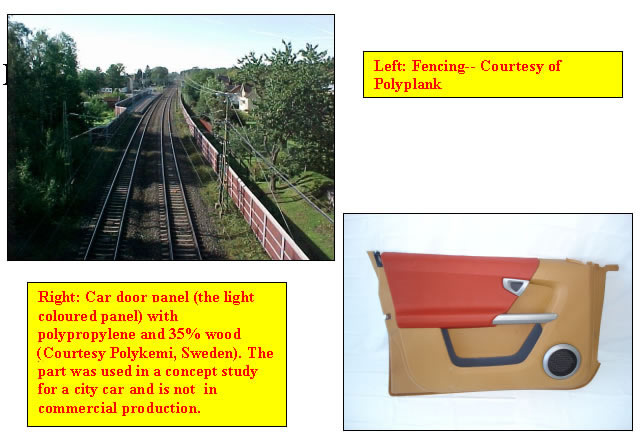|
This is a summary of a "Powerpoint" presentation given by Professor Geoff Pritchard to The Telford Polymer Association on 1 November 2006 |
|
Progress
in Developing Wood Plastics Composites in Europe
|
|
Professor
Geoff Pritchard
|
|
Hackwell
Group
|
Wood and plastics have completely different histories. The two materials have not usually been thought to have much to do with each other, apart from the use of small quantities of wood as a cost-reducing filler for thermosetting plastics in the early years of the twentieth century. But around 1970, Italians successfully developed mixtures of 50% wood and 50% polyolefin resin and used them to make car parts like parcel trays and door panels. The technology eventually found its way to the USA and in the 1990s the Americans tried various other uses for wood plastic composites (WPC) such as picnic tables and decking. The decking application was a great success because although WPC is more expensive than wood, it does not deteriorate in outdoor use to anything like the same extent. In fact properly formulated WPC only needs painting for cosmetic purposes. The
manufacture of WPC decking has been one of the plastics industry’s
big success stories of the late twentieth century, with a seven-fold increase
in sales taking place over about a decade. The low water absorption of
WPC compared with wood is a big advantage, although it disappears when
too much wood is used in the mixture. |
 |
| The success of WPC decking has required manufacturers to climb a steep learning curve because wood is not as easy to handle as mineral fillers. It does not like heating above 200°C and it is usually delivered wet, whereas it needs to be extruded in the dry state. Moreover, after being dried it is prone to dust explosions or fire. Even after drying and mixing with resin, the progress of viscous wood-resin mixtures through the extruder can be difficult. It is now realised that additives like lubricants and process aids can be very helpful. The long term durability of WPC has still to be finally confirmed but likely antioxidants are needed for maximum benefit in sunny climates, and biocides may be beneficial in hot/wet regions. The ideal flame retardant is still being sought, although it should be said that the fire behaviour of WPC is no worse than that of most of its main competitors. In
Europe, the decking market (although growing) is not very big and other
applications have been developed instead. They include automotive parts,
highway sound barriers, cable channel covers, cable drum ends, waterfront
edging, cladding for residential buildings, window and door parts, garden
furniture and various other furniture parts. Although extrusion is by
far the most important fabrication process at present, injection moulding
is set to increase the number and variety of applications of WPC, especially
when resin prices are increasing and it is economically desirable to reduce
resin contents. Nevertheless it must be stressed that wood plastics pellets
are not a cheap option; they sell in Europe at around 800 euros a tonne.
Wood is a natural material and WPC can take a variety of attractive surface
appearances. Strength and stiffness are weak points at present, but some
other mechanical properties (hardness, abrasion resistance, shear strength
and compression strength) are good. WPC can be worked (sawn, nailed etc)
like wood, and screw and nail retention are superior. |
 |

|
It
is not possible to generalise much about the properties of WPC because
there are many different formulations and fabrication processes, and new
companies are bringing new ideas. The technology already exists to improve
the mechanical properties by molecular orientation. Foams can also be
made. |
 |
| Europe
has made some distinctive contributions to the WPC industry, notably the
unique Fasalex formulations which use a good deal of non-petroleum resin,
and it has developed the many automotive applications. More companies
are now joining the market, and further innovations can be expected in
construction and furniture. Among the next applications we might see fasciaboards,
soffits and pallets. |